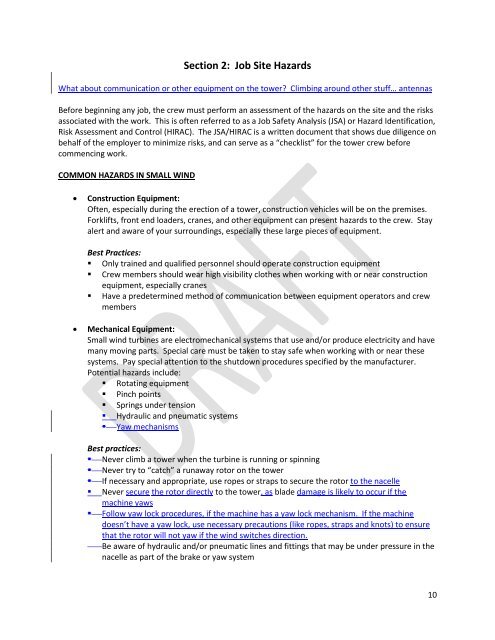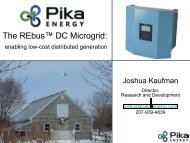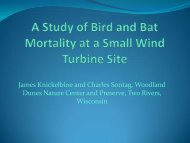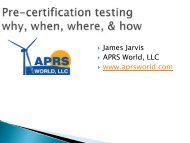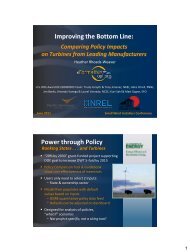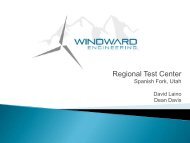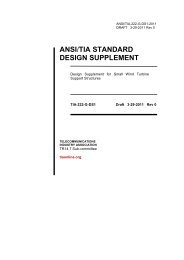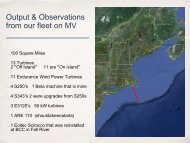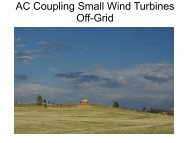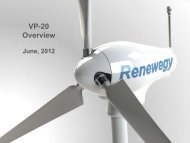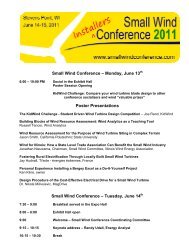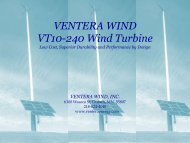Best Practices in Small Wind: Tower Climbing Safety
Best Practices in Small Wind: Tower Climbing Safety
Best Practices in Small Wind: Tower Climbing Safety
You also want an ePaper? Increase the reach of your titles
YUMPU automatically turns print PDFs into web optimized ePapers that Google loves.
Section 2: Job Site Hazards<br />
What about communication or other equipment on the tower? Climb<strong>in</strong>g around other stuff… antennas<br />
Before beg<strong>in</strong>n<strong>in</strong>g any job, the crew must perform an assessment of the hazards on the site and the risks<br />
associated with the work. This is often referred to as a Job <strong>Safety</strong> Analysis (JSA) or Hazard Identification,<br />
Risk Assessment and Control (HIRAC). The JSA/HIRAC is a written document that shows due diligence on<br />
behalf of the employer to m<strong>in</strong>imize risks, and can serve as a “checklist” for the tower crew before<br />
commenc<strong>in</strong>g work.<br />
COMMON HAZARDS IN SMALL WIND<br />
� Construction Equipment:<br />
Often, especially dur<strong>in</strong>g the erection of a tower, construction vehicles will be on the premises.<br />
Forklifts, front end loaders, cranes, and other equipment can present hazards to the crew. Stay<br />
alert and aware of your surround<strong>in</strong>gs, especially these large pieces of equipment.<br />
<strong>Best</strong> <strong>Practices</strong>:<br />
� Only tra<strong>in</strong>ed and qualified personnel should operate construction equipment<br />
� Crew members should wear high visibility clothes when work<strong>in</strong>g with or near construction<br />
equipment, especially cranes<br />
� Have a predeterm<strong>in</strong>ed method of communication between equipment operators and crew<br />
members<br />
� Mechanical Equipment:<br />
<strong>Small</strong> w<strong>in</strong>d turb<strong>in</strong>es are electromechanical systems that use and/or produce electricity and have<br />
many mov<strong>in</strong>g parts. Special care must be taken to stay safe when work<strong>in</strong>g with or near these<br />
systems. Pay special attention to the shutdown procedures specified by the manufacturer.<br />
Potential hazards <strong>in</strong>clude:<br />
� Rotat<strong>in</strong>g equipment<br />
� P<strong>in</strong>ch po<strong>in</strong>ts<br />
� Spr<strong>in</strong>gs under tension<br />
� Hydraulic and pneumatic systems<br />
� Yaw mechanisms<br />
<strong>Best</strong> practices:<br />
� Never climb a tower when the turb<strong>in</strong>e is runn<strong>in</strong>g or sp<strong>in</strong>n<strong>in</strong>g<br />
� Never try to “catch” a runaway rotor on the tower<br />
� If necessary and appropriate, use ropes or straps to secure the rotor to the nacelle<br />
� Never secure the rotor directly to the tower, as blade damage is likely to occur if the<br />
mach<strong>in</strong>e yaws<br />
� Follow yaw lock procedures, if the mach<strong>in</strong>e has a yaw lock mechanism. If the mach<strong>in</strong>e<br />
doesn’t have a yaw lock, use necessary precautions (like ropes, straps and knots) to ensure<br />
that the rotor will not yaw if the w<strong>in</strong>d switches direction.<br />
Be aware of hydraulic and/or pneumatic l<strong>in</strong>es and fitt<strong>in</strong>gs that may be under pressure <strong>in</strong> the<br />
nacelle as part of the brake or yaw system<br />
10


